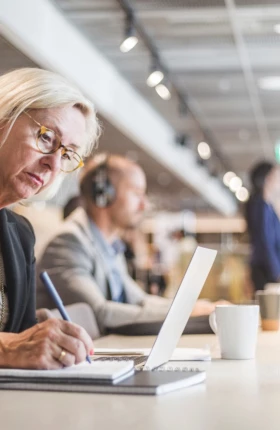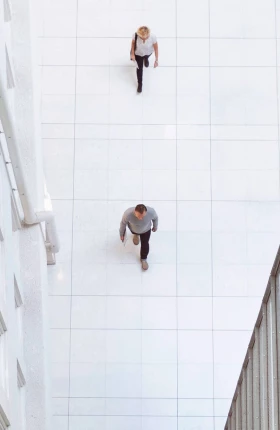COVID-19 has triggered a seismic, structural shift in how we work
The COVID-19 crisis has activated a modern industrial revolution. It has forced a rapid shift in where and how most Australians work, and broken through longstanding barriers to change in just three months. To understand this shift, BCG conducted an online workforce sentiment survey of 1002 people to uncover experiences and attitudes to working during COVID-19. The survey findings provide a snapshot of how employees feel about work.
Some findings are intuitive, such as three-quarters of employees faced barriers to working during COVID-19, but nearly the same number also experienced positive impacts on their work. Other findings counter past preconceptions. Employees who can work remotely want to keep doing so, but not every day, confirming that the office still has a role – albeit a changing one. Employees who work remotely also believe their productivity has increased.
But underneath the surface-level analysis and average responses there are a wide variety of personal situations, and employee needs, each one often very different to the last. What some people crave is completely irrelevant to others. So as we transition to the next reality, the question for employers is, ‘What are these needs and how can understanding this be a source of competitive advantage?’
To understand this BCG clustered the survey data and identified eight employee segments. The people within each segment have similar attributes and needs, but are very different to the other segments. Knowing how your organisation’s employee break down across these segments, means you can design custom-fit Employee Value Propositions that address specific needs and aspirations. The organisations that get this right will have a clear advantage in the war for talent.
Finding #1: Most people who can work remotely want to…but not every day
Before COVID-19, there was an almost even split between people who worked exclusively on-site (48%) and people who incorporated some degree of remote working into their routines (52%). However, after having a better taste of remote life during COVID-19 restrictions, those who are able to work remotely, want to do more of this in the future. Counter to past preconceptions, people don’t want to work at home all the time.
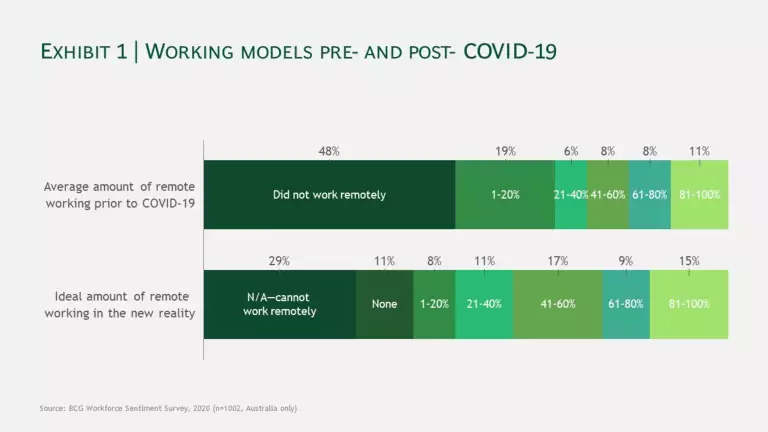
For people who can perform their duties from home, the most popular model is a hybrid, working 2-3 days a week from home across a 5 day week (41-60%). This model was the most popular, with differences of opinion on the optimal split of time between home and office. Interestingly, people aged 60+ who can work remotely had the strongest preference for a model with 81-100% of time spent on remote work.
Finding #2: 76% of Australians faced barriers to working during COVID-19, with the most affected being the younger age groups, and (unsurprisingly) those with children at home
2020 has been a year of rapid change and, as people have navigated new ways of working, many barriers have emerged. Just over three-quarters (76%) of people indicated that they had experienced at least one negative impact since COVID-19 restrictions came in. Noting that some of these impacts are temporary, the main barriers faced by employees as a whole were decreased income, feelings of anxiety, depression and/or loneliness, decreased work life balance and increased distractions when working from home.
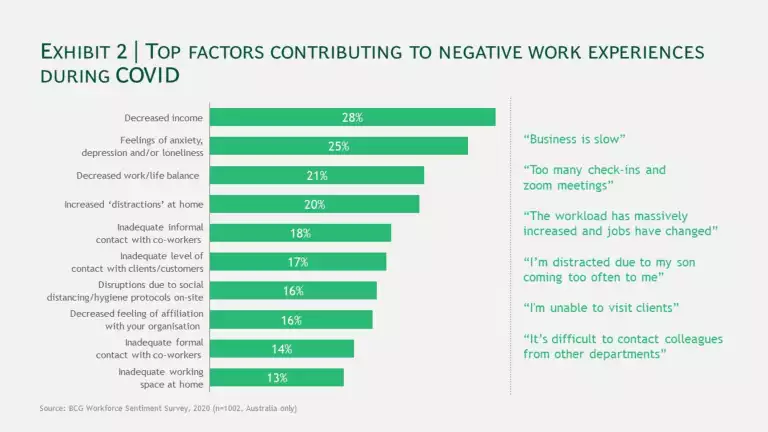
Finding #3: 69% of Australians also experienced positive impacts on their work, highlighting good practices to retain post-COVID
While we have seen that most Australians experienced at least one barrier, the news is not all bad: 69% also found these new ways of working to be a positive experience. The main positive impacts experienced by employees were improved safety, increased work life balance, and better flexibility in working arrangements and hours.
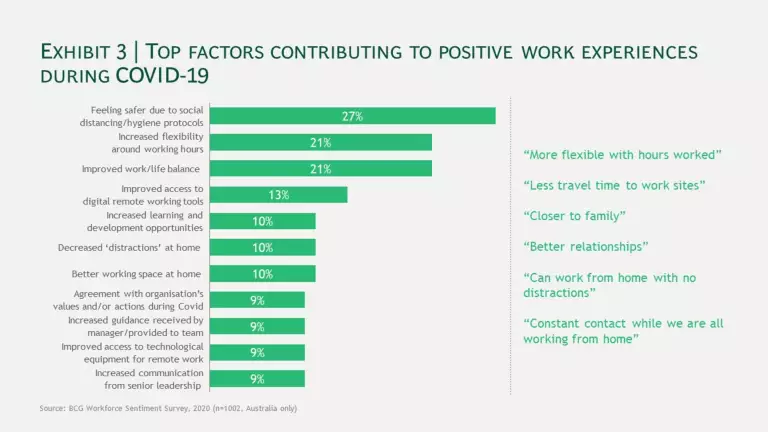
Finding #4: Counter to historic concerns, people who have now been working remotely believe, on average, they have increased their productivity, engagement and achievement
Many people have been thrown into a working model that wasn’t an option for them before COVID-19, and have been pleasantly surprised by the results, proving that remote and hybrid models do work. On the whole, employees have worked out how to balance the barriers with the positive impacts to thrive in the new reality, and the benefits of this increased productivity, engagement and effectiveness flows directly to employers.
Despite the long-standing fear of many employers that remote working could have negative effects, those fears seem to be unfounded: over half the employees surveyed (excluding those on JobKeeper) did not feel their productivity and engagement had declined during COVID-19 restrictions.
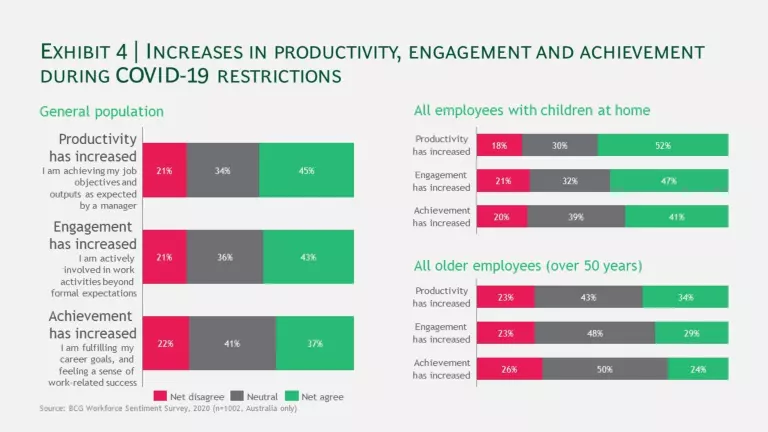
Finding #5: Mutual trust between employees and their employers is vital for a strong working relationship
The most common positive impact felt by people during this period was ‘feeling safe’. Trust during COVID-19 is linked to physical safety and psychological factors such as job stability, security and autonomy to get work done.
- 83% of employees stated that trust in their employer is important
- 65% of employees believe their employer will only bring them back into offices and worksites when it is safe to do so, and 26% feel neutral on the subject
- 58% say that trust in their employer has increased during COVID-19 – this figure was higher for those who have been able to work remotely (63%)
- For 85% of people who have autonomy, their productivity, engagement and achievement increased.
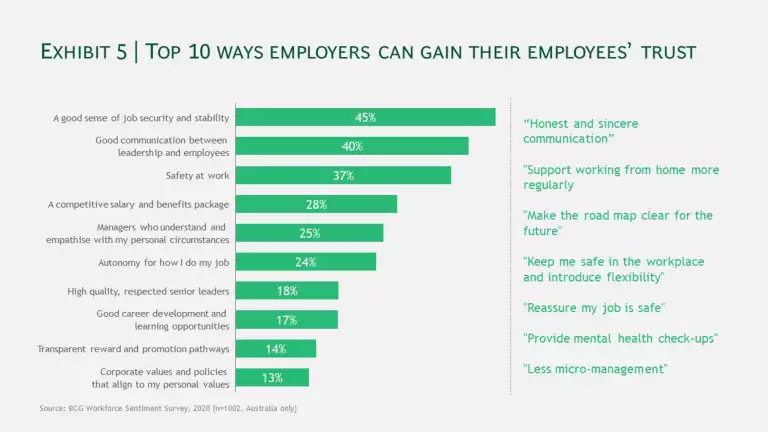
Finding #6: Most Australians still see a role for the office, but the need it fulfils isn’t the same for everyone
The traditional working model for many people has been ‘office by default, remote by exception’. Now that COVID-19 has changed this, organisations are starting to question whether an office is still necessary. From the research, it’s clear the office still has a role:
- 77% of employees miss some elements of being in an office during this period
- 57% of people are excited to go back to their workplace when restrictions ease
- People with children at home feel this excitement more (64% versus 50% for those that don’t have kids
- Men are more enthusiastic about returning to offices than their female colleagues (62% versus 53%)
- Younger employees are also more ready to return to offices, with 66% of 18-30-year-olds feeling enthusiastic about going back, versus only 47% of 51-60-year-olds
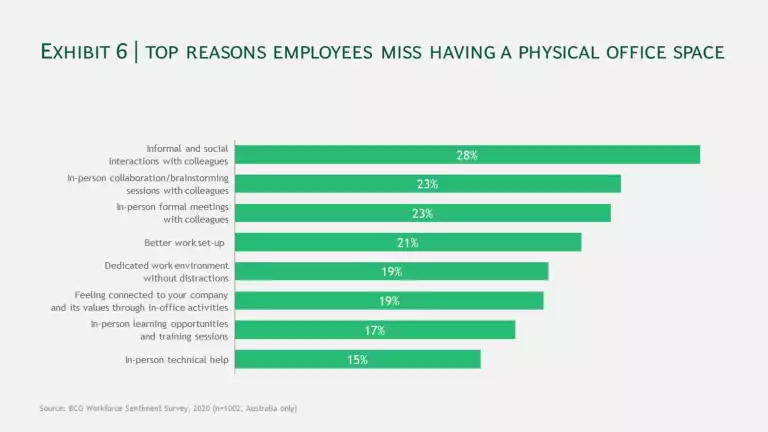
DIGGING BENEATH THE DATA TO UNDERSTAND EMPLOYEE NEEDS AND HOW TO MEET THEM
What became evident from the research is that everyone’s circumstances are different. Everyone wants and needs different things. We are all weathering the same COVID-19 storm, but we are navigating it in different boats. Digging beneath the averages, we were able to see clusters of people – groups that, while not identical, had similar identifiable attributes (age, profession, income, family etc.) and similar needs.
This process yielded eight employee segments described in Exhibit 7 below. Each segment is experiencing the COVID-19 crisis differently, with different needs to different degrees. And each segment also has specific expectations of their employers and their workplaces.
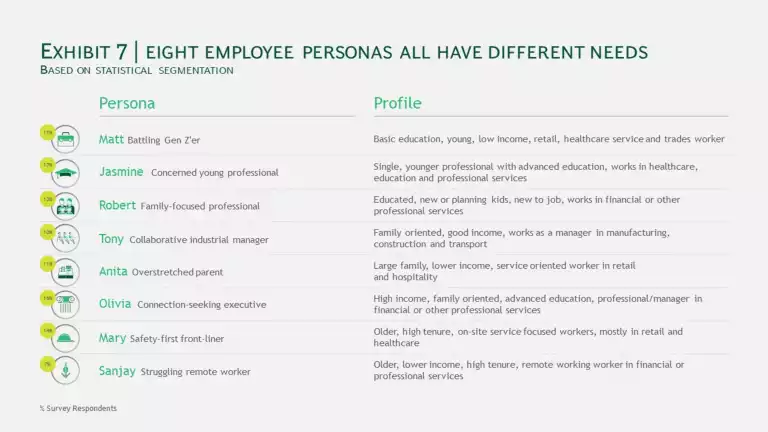
The downloadable pdf report has more detail on these segments and how organisations can use them to design custom-fit EVPs that address the specific needs and aspirations of their employees.
While organisations can’t do everything at once, they understand which actions will have greatest value for their employees, and create tailored EVPs that fulfil career objectives and increase productivity, engagement and sense of achievement. What’s clear is that a one-size-fits-all approach won’t work. There will be too much wasted effort, too many meaningless policies, and mismatched expectations and interactions between your employees.
But imagine a world where your enterprise policies resonated perfectly with the people in your business. Imagine if your team members understood each other and were able to work collaboratively and cohesively, teaming so everyone (including the business) is happy and productive. Imagine if you could train your leaders to have empathetic 1:1 conversations with their team members, easily able to hone in quickly on what’s important to that person at that moment in time.
This is the opportunity, to personalise for your people, and the organisations that get this right will have a clear advantage in the race for talent.


